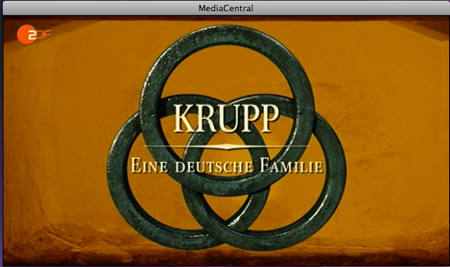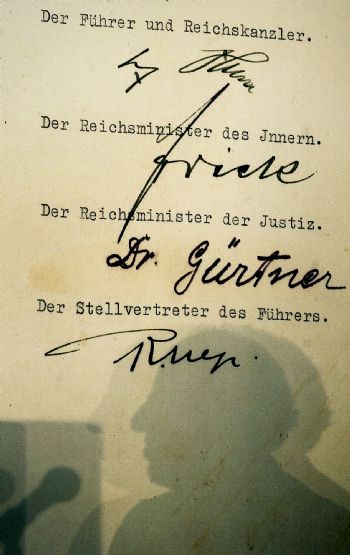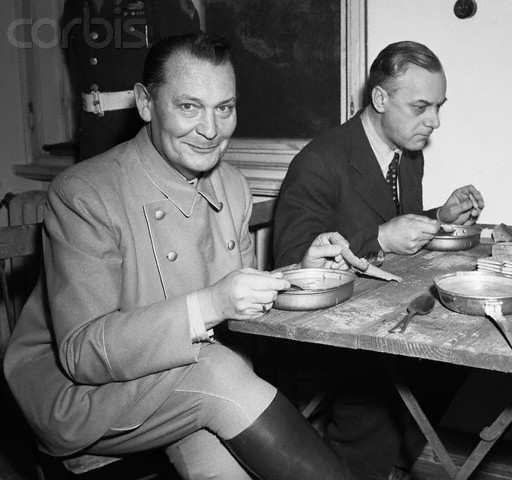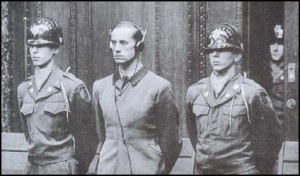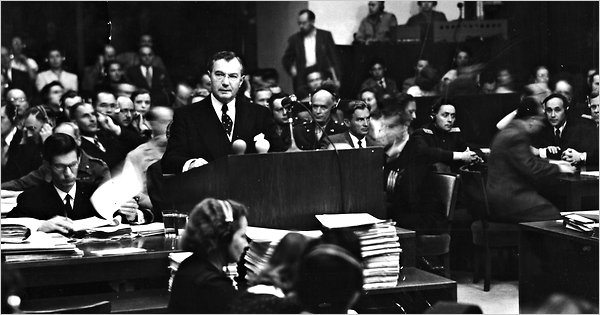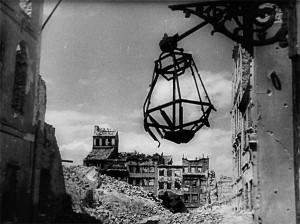Alex Constantine - May 12, 2010
By Sybille Fuchs (repost)
29 April 2004
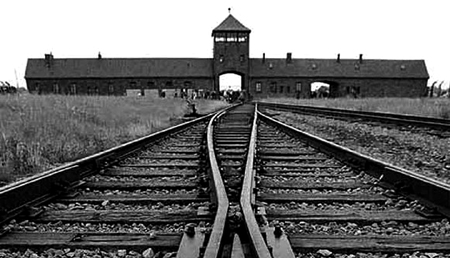 After the Nuremberg Trials organised by the allied forces, in which only a handful of Nazi, or National Socialist, leaders were accused and sentenced for their crimes, a strange silence about the extermination camps dominated the early days of the Federal Republic of Germany.
After the Nuremberg Trials organised by the allied forces, in which only a handful of Nazi, or National Socialist, leaders were accused and sentenced for their crimes, a strange silence about the extermination camps dominated the early days of the Federal Republic of Germany.
The Cold War dominated politics and the media, and shortly after the founding of the Federal Republic in 1949, the allies dropped their pursuit of Nazi criminals and handed the task over to the German justice system. With the approval of the allies, jailed business leaders such as Alfried Krupp, who had directly profited from the concentration camp prisoners, were released after short periods of detention and allowed to resume their leading company posts.
On May 29, 1949, a law was passed prohibiting the extradition of German nationals. Consequently, scores of Nazis who committed their crimes in other countries were never handed over to these nations. The German judiciary only initiated action against Nazi war criminals in rare cases.
All those who committed offences during the Nazi regime and had subsequently received a sentence of less than a year were granted amnesty. In 1954, this was extended to all those with sentences of up to three years. It meant that anyone not implicated in major crimes simply went free. In addition, offences like the “concealment of a person’s rank for political reasons” were granted amnesty. These measures made it easier for many of the main criminals to go into hiding. [1]
“In the meantime, the western allies experienced a case of ‘clemency fever.’ As a prosecutor from Nuremberg, Robert Kempner, later observed, almost all of his sentenced Nazi criminals were pardoned.... [I]n 1953 most of them found themselves free men and the last one was released in 1958.” [2]
Chancellor Konrad Adenauer’s government—the first German federal republic after the war—included high-ranking Nazis such as Theodor Oberländer [3] and Hans Globke. This permitted Oswald Kaduk, who had been accused of particularly heinous crimes, to declare: “I don’t understand why I was apprehended and taken away while those who are really guilty are free. When I just think about permanent secretary Globke....”
Hans Globke, who had only recently served as state secretary in the German chancellor’s office in Bonn, was the co-author of a 1936 commentary on the Nuremberg race laws. It served as a basic manual for judges, concentration camp guards and Wehrmacht officers, explaining how Jews, Sinti, and Gypsies—these “foreign species”—should be dealt with. Neither Globke nor any of the judges who sentenced Jews and others regarded as “untermenschen” (subhumans) to death or other draconian punishments, ever faced court.
Judges who had willingly served under the Nazi dictatorship were back in office or collecting a pension, enjoying their lives in peace. Moreover, after the rearmament of Germany, officers from Hitler’s Wehrmacht were brought back to build a new national army, without any close examination being made of their histories.
Systematic criminal proceedings against former Nazis never took place in the Federal Republic, nor have their victims ever been given adequate compensation. Up to the present day, those who profited from Auschwitz, like the heirs to steel magnate Friedrich Flick, have refused to pay compensation to forced labourers. Likewise, the former heads of the now-defunct chemical giant IG-Farben have not been brought to account for their actions. Among them is Heinrich Bütefisch, to whom the federal government awarded the Federal Cross of Merit, even though he was sentenced during the Nuremberg Trials.
Bütefisch, in his capacity as IG-Farben director, was one of those jointly responsible for the exploitation of Auschwitz prisoners. Moreover, he had belonged to the exclusive Freundeskreis des Reichsführers SS (Gestapo and SS chief Heinrich Himmler’s circle of friends) and had obtained the rank of an SS-Obersturmführer. When these facts became known, German President Heinrich Lübke ordered the return of Bütefisch’s medal.
It was not until 1958 that an organisation—the Ludwigsburger Zentralstelle—was founded to specifically prosecute these crimes. These measures, however, had nothing to do with the systematic pursuit of Nazis.
In total, fewer than 500 were punished for their participation in the murder of Jews. Only 100 defendants from a total of 4,500 who stood trial between 1945 and 1949 for Nazi crimes were accused of murder-related offences (Die Zeit, 5/1/2003). None of the Nazi judges responsible for the scandalous perversion of justice in the notorious “people’s courts” was successfully prosecuted. In fact, it was not until the 1990s that the Federal Supreme Court admitted that the sparing of these judges was a “legislative mistake” and that their crimes should have been punished.
One of the first laws passed in the new Federal Republic of Germany was the so-called exemption from punishment law. This legislation pardoned all those who had committed crimes and been sentenced from six months’ to a year’s jail, with the chance of probation. In 1950, the Bundestag (German parliament) recommended that the process of denazification be ended. During the 1950s, with politics and the media dominated by the German post-war economic miracle, the Cold War, and the fight against the enemy in the east, law after law were passed, most with the explicit endorsement of the allied forces, allowing Nazi criminals to go unpunished.
Following the half-hearted “denazification” program, almost the entire middle and upper strata of the National Socialists’ apparatus of annihilation were integrated back into the justice system and government administration.
In 1960, after the Bundestag had repealed all decrees issued by the allied forces during the 1950s, the German parliament dropped prosecutions for Nazi crimes and killings apart from provable acts of murder. As Fritz Bauer remarked at the time, it was understandable that the public prosecutor’s offices and courts believed that “according to legislation and the executive, juridical dealings with the past are over.” [4]
The general unwillingness to pursue Nazi criminals had an impact on the Auschwitz trials. Investigating judge Hans Düx recalled the following incident: “A hasty letter was sent through the regular channels to the Soviet embassy in Bonn but was held up for days at the ministry of justice in Wiesbaden because the letter used the abbreviation DDR [Democratic Republic of Germany—the former East Germany]. The ministry insisted that the description ‘Soviet Occupation Zone (SBZ)’ should have been used.” [5]
In fact, the Auschwitz trial initiated the scandalous debate, which then dragged on for years, over the abolition of a limitation period for those guilty of murder. Finally, a Bundestag resolution on July16, 1979, lifted the time limit applied to those responsible for murder and genocide. Absurdly, however, the first paragraph in the 1954 penal code could not be retrospectively applied to Nazi crimes committed in the past. The lifting of the limitation was therefore only applicable for future acts of genocide. [6]
Even if the legal consequences of the Auschwitz trial did not go anywhere near fulfilling the hopes of many of the victims and of those who initiated the hearings, it did change the intellectual climate in the Federal Republic. The naked truth about the extermination camps, illuminated during the proceedings, made many—above all young people—continually ask how and why this monstrous crime occurred. What were the real causes of National Socialism? Why was it able to take power?
Why was resistance so weak? Why had the Weimar Republic failed so pitifully? Why had the working class, assembled in powerful organisations—the trade unions, the Social Democratic and Communist parties—-let Hitler come to power? What were the causes for the splitting of the workers’ movement? Why did the working class not join in a common struggle against fascism?
These questions, which have the same relevance today as 40 years ago, can only be answered through a serious study of history. The only conclusive answers to these questions can be found in the analyses and articles written by Leon Trotsky, which have since been historically confirmed. Auschwitz would not have been possible without the rise of Stalinism and its domination of the Communist International.
The anniversary of the Auschwitz trial provides an opportunity to once again study these issues.
Notes
1. Furchtbare Juristen by Ingo Müller, München, 1987, p.242
2. ibid., p.244
3. Theodor Oberländer was the minister for expelled Germans in the Adenauer government. He belonged to the academic elite of the National Socialists and was also an official in the foreign/defence ministries responsible for the occupation of eastern Europe. He was forced out of government in 1960, after being sentenced to life for war crimes in East Berlin.
4. Müller, p.244
5. Zufallsprodukt Auschwitzprozess by Hans Düx (http://www.rav.de/infobrief90/duex.htm)
6. Müller, p.249
